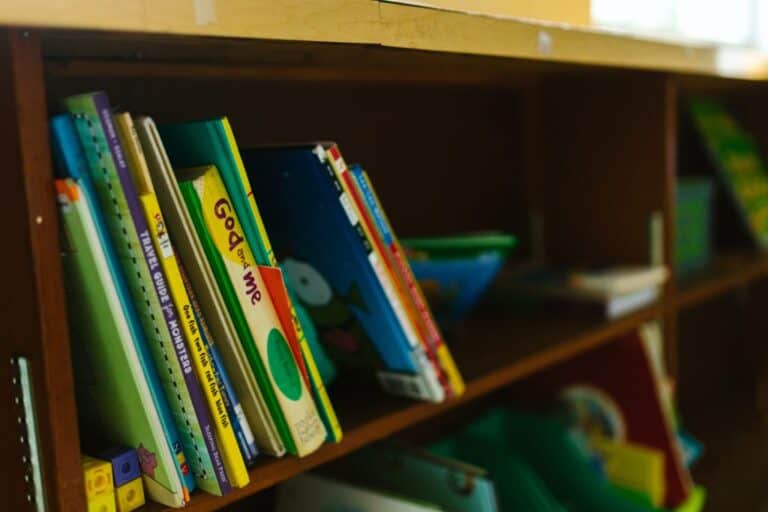Books for 11-Year-Olds That Spark Imagination
We may earn money from the products/companies mentioned in this post. As an Amazon Associate I earn from qualifying purchases. For more information, read our Terms & Disclosures.
Remember when books were portals to other worlds?
Well, they still are! As our kids stand on the cusp of the grand old age of eleven, it’s the perfect time to introduce them to classic children’s literature that will turn them into lifelong readers.
Best Books For 11 Year Old’s
Notable Children’s Classics
Why not start with the books that have been children’s gateways to imagination for generations? Share stories that have stood the test of time and watch your child’s eyes light up with the same wonder that kids have felt for over a century.
“Charlotte’s Web” by E.B. White – This timeless story of friendship and life on a farm centers around a pig named Wilbur and his spider friend, Charlotte.
“The Secret Garden” by Frances Hodgson Burnett – A tale of transformation and the healing power of nature, it follows the story of Mary Lennox and her discovery of a hidden, neglected garden.
“Alice’s Adventures in Wonderland” by Lewis Carroll – An imaginative and whimsical journey of a young girl named Alice who falls through a rabbit hole into a fantastical world.
“The Chronicles of Narnia” by C.S. Lewis – A series that takes readers on an epic adventure through the magical land of Narnia, filled with talking animals, mythical creatures, and timeless battles between good and evil.
“Anne of Green Gables” by L.M. Montgomery – The story of Anne Shirley, an imaginative, red-haired orphan, who brings joy, love, and adventure to the lives of her adoptive parents in the small town of Avonlea.
Essential Preteen Novels
From The Giver series to modern classics, fantasy novels are like the pizza of literature: universally loved and devoured with enthusiasm.
“Percy Jackson & The Olympians: The Lightning Thief” by Rick Riordan – A modern-day demigod, Percy Jackson discovers his heritage and embarks on a quest to prevent a war among the Greek gods.
“Holes” by Louis Sachar – This novel follows Stanley Yelnats as he unravels the mystery behind his family’s curse while digging holes at a juvenile detention center.
“The Giver” by Lois Lowry – A thought-provoking novel set in a seemingly utopian society where a boy named Jonas uncovers the dark truths of his community’s existence.
“A Wrinkle in Time” by Madeleine L’Engle – This science fantasy novel takes Meg Murry, her brother Charles Wallace, and their friend Calvin on a space-time adventure to rescue Meg’s father and defeat darkness.
Engaging Literature for Children
Books filled with adventure can teach resilience and the spirit of exploration, perfect for the young Indiana Jones in your life.
“The Tale of Despereaux” by Kate DiCamillo – A brave mouse, a princess, soup, and a spool of thread intertwine in this charming tale of bravery and forgiveness.
“The BFG” by Roald Dahl – The story of a young girl named Sophie and her adventures with the Big Friendly Giant, who’s quite unlike other giants.
“Matilda” by Roald Dahl – The extraordinary Matilda is a smart, independent young girl who loves to read and ends up with magical powers.
“Diary of a Wimpy Kid” by Jeff Kinney – A series that follows the humorous adventures of Greg Heffley, a middle-schooler trying to navigate the complexities of school and family life.
“Where the Wild Things Are” by Maurice Sendak – A beautifully illustrated tale of Max, who dons his wolf suit in pursuit of some mischief and finds himself in the land of the Wild Things.
Children’s Programming Books
While we’re on the topic of science fiction, why not sneak in some real-world tech skills? Books about coding for kids can make them the next tech whiz—just hopefully not the kind that crashes the family computer.
“Hello Ruby: Adventures in Coding” by Linda Liukas – Follows the adventures of Ruby, a small girl with a big imagination, as she whimsically explores the fundamentals of coding.
“Coding Games in Scratch: A Step-by-Step Visual Guide to Building Your Own Computer Games” by Jon Woodcock – Offers a visual guide to building interactive computer games using Scratch, making it engaging for kids to learn programming concepts.
“Python for Kids: A Playful Introduction to Programming” by Jason R. Briggs – Introduces Python programming with easy-to-follow instructions and fun examples that get kids coding their own projects.
“Get Coding!: Learn HTML, CSS & JavaScript & Build a Website, App & Game” by Young Rewired State – Teaches children the basics of HTML, CSS, and JavaScript through the fun activity of building their own website, app, and game.
“Lauren Ipsum: A Story About Computer Science and Other Improbable Things” by Carlos Bueno – A whimsical journey through a fantastical land where logic and computer science principles are woven into the adventure.
Books on Friendship for Children
As our kids navigate the social maze of preteen years, books about friendship and even kindness can be both a comfort and a guide.
“Wonder” by R.J. Palacio – This powerful novel tells the story of August Pullman, a boy with facial differences who attends a mainstream school for the first time. The book explores themes of friendship, acceptance, and the struggle to fit in from various perspectives.
“Bridge to Terabithia” by Katherine Paterson – A poignant tale of two lonely children who create a magical forest kingdom. The book deals with the deep bond of friendship and the pain of loss.
“The Outsiders” by S.E. Hinton – Focusing on the lives of two groups from different socioeconomic backgrounds, this novel is a compelling look at how friendship can cross social barriers and how loyalty and support are essential during tough times.
Cultivating a Reading Habit in 11-Year-Olds
Encouraging your 11-year-old to read isn’t just about giving them a quiet activity. It’s about opening the doors to new worlds, ideas, and experiences.
At this age, children are at a crucial stage where reading can significantly influence their cognitive development, vocabulary expansion, and understanding of diverse cultures and perspectives.
The Benefits of Reading for Preteens
Reading at this stage can also bolster academic performance across all subjects. It’s not just about literacy; children who read widely tend to have better concentration, memory, and analytical skills.
Moreover, literature can be a mirror and a window – it allows children to reflect on their own experiences and gives them a glimpse into lives different from their own, nurturing empathy and emotional intelligence.
Making Reading a Fun and Engaging Activity
To make reading a habit, it must be enjoyable. This isn’t the time for enforced reading lists or heavy-handed assignments.
Instead, help your child discover the joy of reading by finding books that align with their interests.
Do they love the outdoors? Adventure novels might be just the ticket. Are they into technology? There are fantastic science fiction stories and books on coding tailored to their age group.
Tips for Integrating Reading into Everyday Life
Create a Reading Nook: Set up a cozy corner specifically for reading. A comfortable chair, good lighting, and a mini-shelf with a variety of books can make all the difference.
Lead by Example: Let your child see you reading. Discussing books you love shows them that reading isn’t a chore; it’s a lifelong pleasure.
Use Technology: For tech-savvy kids, e-readers and reading apps can make reading more interactive and engaging.
Book Clubs for Kids: Encourage them to join or start a book club, either in school or in your community. Discussing books with peers can be a powerful motivator.
Reading Challenges: Gamify the reading experience with challenges. Set a number of books to read over the summer or during school breaks, with fun rewards for meeting goals.
Finding the Right Books
Take them to libraries and bookstores and let them roam. Subscription boxes that deliver a new book each month can also be exciting and offer something to look forward to. The key is to provide access and opportunities to explore books of all kinds.
Conclusion: Building a Library That Grows with Your Child
Creating a library for your child is like planting a tree. It takes time to grow, but eventually, it provides shade, comfort, and a few good places to hide for hide-and-seek. Equip your preteen’s imagination with books that will last them a lifetime—or at least until the next report card.
Happy reading, and remember: the right book can turn “I’m bored” into “I’m on a dragon, flying over a volcano, solving mysteries, and saving an alien species. Can dinner wait?”
Embark on a Literary Journey with Your Child! Discover our ‘Ultimate Guide to Choosing the Perfect Books for Kids: From Toddlers to Tweens’ — your comprehensive roadmap to unlocking the magic of reading at every stage of your child’s development.
Whether your little one is just grasping board books or your tween is diving into complex worlds, our guide serves as your trusted companion in nurturing a lifelong love for reading. Dive into our guide and watch your child’s imagination and knowledge soar with every page turned!

